Consider an economy that lasts for two periods. A household receives nominal labour income Y1 = 100 in the first period and Y2 = 110 in the second period. The price level in the first period is P1 and in the second period it's P2 = 11. The nominal interest rate i is 15%. Household chooses real 10 consumption c1 and c2 (relative to price level in the first period) to maximise utility U(c1,c2) that exhibits the decreasing marginal rate of substitution property. 1. Calculate the inflation rate 7 and the real interest rate r. 2. Find the real consumption values for which the household neither saves, nor borrows. For all questions below assume that this is the optimal choice for the housheold. 3. Draw and describe analytically the set of feasible consumption choices. What is the
Consider an economy that lasts for two periods. A household receives nominal labour income Y1 = 100 in the first period and Y2 = 110 in the second period. The price level in the first period is P1 and in the second period it's P2 = 11. The nominal interest rate i is 15%. Household chooses real 10 consumption c1 and c2 (relative to price level in the first period) to maximise utility U(c1,c2) that exhibits the decreasing marginal rate of substitution property. 1. Calculate the inflation rate 7 and the real interest rate r. 2. Find the real consumption values for which the household neither saves, nor borrows. For all questions below assume that this is the optimal choice for the housheold. 3. Draw and describe analytically the set of feasible consumption choices. What is the
Economics: Private and Public Choice (MindTap Course List)
16th Edition
ISBN:9781305506725
Author:James D. Gwartney, Richard L. Stroup, Russell S. Sobel, David A. Macpherson
Publisher:James D. Gwartney, Richard L. Stroup, Russell S. Sobel, David A. Macpherson
Chapter9: An Introduction To Basic Macroeconomic Markets
Section: Chapter Questions
Problem 9CQ
Related questions
Question

Transcribed Image Text:Consider an economy that lasts for two periods. A household receives nominal labour income Y1 = 100
in the first period and Y2 = 110 in the second period. The price level in the first period is P = 10
and in the second period it's P, = 11. The nominal interest rate i is 15%. Household chooses real
consumption c1 and c2 (relative to price level in the first period) to maximise utility U(c1, c2) that
exhibits the decreasing marginal rate of substitution property.
1.
Calculate the inflation rate 7 and the real interest rate r.
2.
Find the real consumption values for which the household neither saves, nor borrows.
For all questions below assume that this is the optimal choice for the housheold.
3.
Draw and describe analytically the set of feasible consumption choices. What is the
marginal rate of substitution at the optimal choice?
4.
Now assume that due to increase in risk premia, banks introduce a spread on interest
rates, borrowers now pay ry = r + 1% and lenders get ri = r – 1% on their savings. Show
graphically how this affects the set of feasible consumption choices.
5.
Can the introduction of the interest rate spread affect the optimal consumption choice
of the household? Why/Why not?
Expert Solution
This question has been solved!
Explore an expertly crafted, step-by-step solution for a thorough understanding of key concepts.
Step by step
Solved in 2 steps with 1 images

Knowledge Booster
Learn more about
Need a deep-dive on the concept behind this application? Look no further. Learn more about this topic, economics and related others by exploring similar questions and additional content below.Recommended textbooks for you

Economics: Private and Public Choice (MindTap Cou…
Economics
ISBN:
9781305506725
Author:
James D. Gwartney, Richard L. Stroup, Russell S. Sobel, David A. Macpherson
Publisher:
Cengage Learning

Macroeconomics: Private and Public Choice (MindTa…
Economics
ISBN:
9781305506756
Author:
James D. Gwartney, Richard L. Stroup, Russell S. Sobel, David A. Macpherson
Publisher:
Cengage Learning


Economics: Private and Public Choice (MindTap Cou…
Economics
ISBN:
9781305506725
Author:
James D. Gwartney, Richard L. Stroup, Russell S. Sobel, David A. Macpherson
Publisher:
Cengage Learning

Macroeconomics: Private and Public Choice (MindTa…
Economics
ISBN:
9781305506756
Author:
James D. Gwartney, Richard L. Stroup, Russell S. Sobel, David A. Macpherson
Publisher:
Cengage Learning


Economics (MindTap Course List)
Economics
ISBN:
9781337617383
Author:
Roger A. Arnold
Publisher:
Cengage Learning

